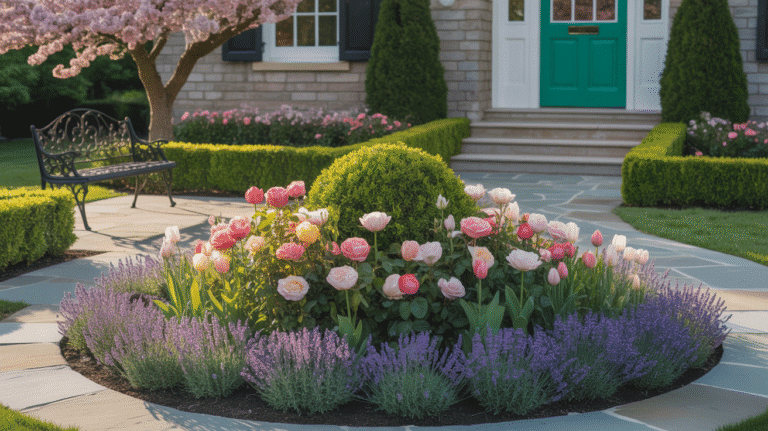Using sustainable gardening practices is key to a healthier planet. Eco-friendly methods help gardeners cut down their environmental impact.
Switching to greener gardening is good for the planet and makes gardening better. It means using nature’s resources carefully and throwing away less.
Exploring eco-friendly gardening shows us that small steps can lead to big changes. By picking sustainable ways, gardeners help our community become more eco-aware.
Key Takeaways
- Adopting sustainable gardening practices reduces environmental impact.
- Eco-friendly gardening methods promote a healthier planet.
- Simple changes in gardening habits can lead to significant positive changes.
- Sustainable gardening enhances the overall gardening experience.
- Natural resources should be used wisely in gardening.
The Importance of Eco-Friendly Gardening
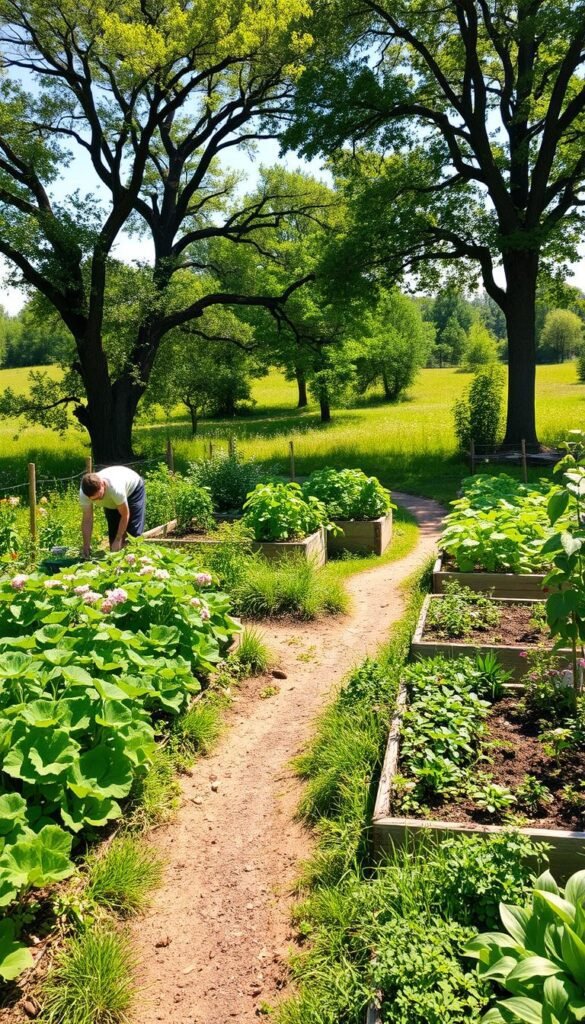
Eco-friendly gardening is key for a sustainable future. By using environmentally-friendly gardening tips and green gardening techniques, we can help the environment. This makes a big difference.
Eco-friendly gardening is more than just avoiding harm. It’s about making a positive change. It keeps soil healthy, saves water, and cuts down on waste. This helps the environment and supports local wildlife.
It also helps fight climate change. By choosing organic materials and reducing chemicals, we lower our carbon footprint. Eco-friendly gardens can even pull CO2 from the air.
Green gardening techniques like composting and using native plants are easy and effective. Composting turns waste into soil, avoiding synthetic fertilizers. Native plants need less care and help local ecosystems.
Also, eco-friendly gardens are good for us. They’re free from harmful chemicals and full of life. They boost mental health and let us connect with nature.
In short, eco-friendly gardening is very important. By following environmentally-friendly gardening tips, we can make gardens that are good for us and the planet. Let’s keep promoting sustainable gardening.
Choosing Native Plants for Your Garden
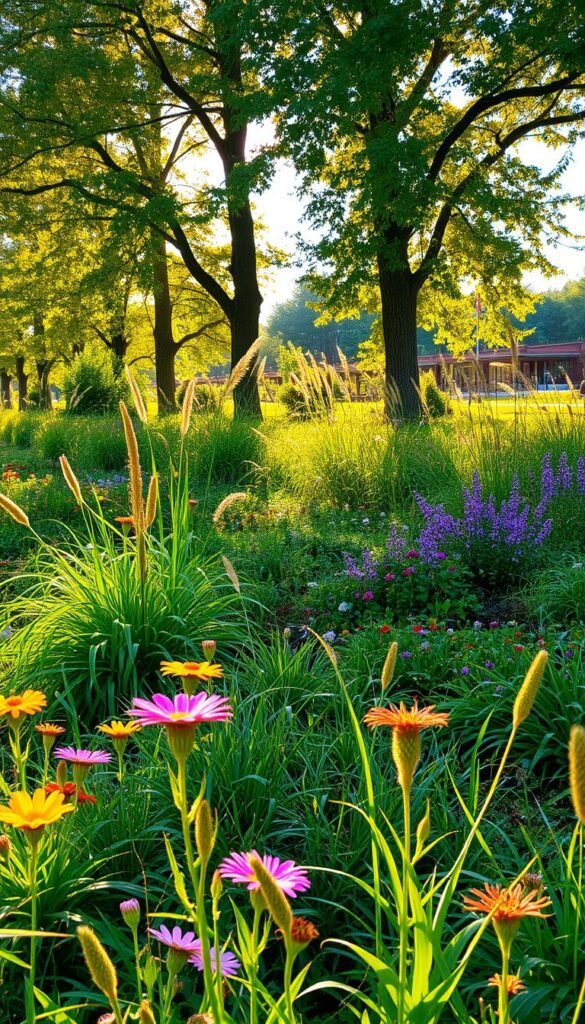
For a garden that thrives with minimal environmental impact, choose native plants. They are naturally adapted to the local climate and soil. This makes them a perfect choice for eco-friendly gardening.
Native plants have many benefits. They require low maintenance and have natural resistance to pests. This means gardeners can use fewer chemical pesticides and fertilizers. This helps create a healthier environment.
Low Maintenance and High Yield
Native plants are great because they thrive with little care. They are more resistant to local pests and diseases. This reduces the need for chemical treatments.
Also, native plants need less watering and fertilization. This makes them a sustainable choice for gardeners.
By using native plants in your garden, you lower your environmental impact. You also create a home for local wildlife. This approach to gardening is a step towards eco-friendly garden solutions and natural pest control for gardens.
Organic Soil Health: The Foundation of Eco-Friendly Gardening
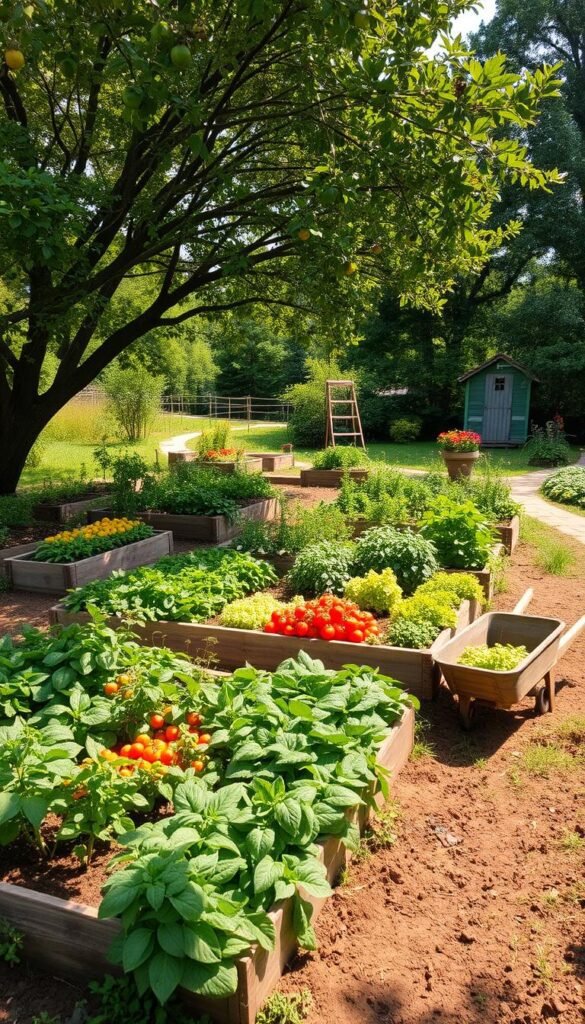
Keeping organic soil health in check is key for green gardening. Healthy soil is full of tiny life forms. They break down organic matter, fight off plant diseases, and help plants absorb nutrients.
Creating a compost pile from kitchen scraps, leaves, and grass clippings is a smart move. It cuts down on waste and adds nutrients to the soil. Compost makes the soil better at holding water, improves its structure, and boosts microbial life.
Other organic gardening methods include using cover crops, rotating crops, and reducing tillage. Cover crops keep weeds down, stop soil erosion, and add organic material. Rotating crops makes the soil more fertile and lowers pest and disease risks.
Less tillage means more soil organic matter and less erosion risk. It also keeps the soil’s tiny life forms healthy. By using these methods, gardeners can build a strong, sustainable garden that’s good for the planet and for them.
Water Conservation Techniques
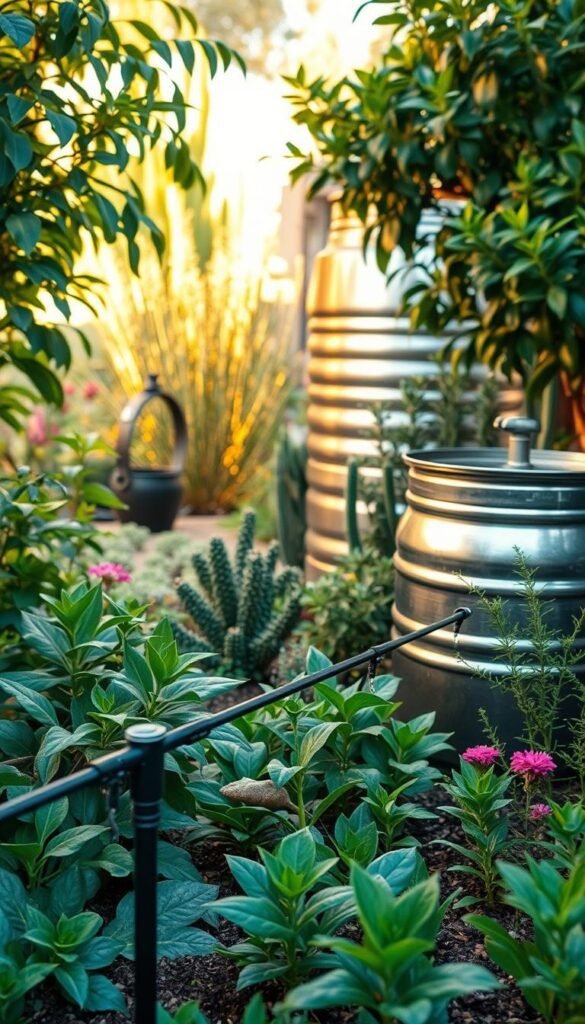
As gardeners, we must use water-saving techniques to help the environment. One key method is using efficient irrigation systems.
Systems like drip irrigation and soaker hoses send water straight to plant roots. This cuts down on evaporation and runoff. It also helps plants grow better.
Efficient Irrigation Methods:
Drip irrigation systems slowly release water, letting it soak deep into the soil. This means we don’t have to water as often.
Soaker hoses spread water along their length, giving plants a steady supply. This is another smart way to water.
We can also mulch garden beds to keep moisture in. Using rain barrels to collect water is another good idea. Plus, picking plants that don’t need much water helps too.
Mulching keeps the soil cool and stops moisture from escaping. Rain barrels give us natural water for our plants, saving city water.
By using these methods, we can use less water in our gardens. This helps make our future more sustainable.
Pest Management: Embracing Nature’s Solutions
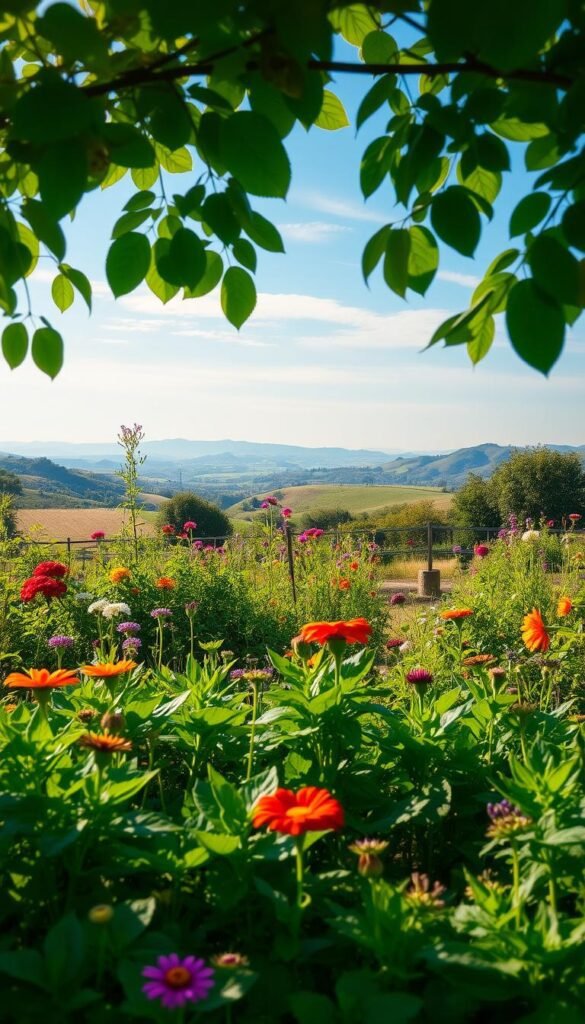
Using nature’s ways to fight pests is key to green gardening. Eco-friendly pest control helps keep plants safe and the environment healthy.
One top method is to encourage beneficial insects in your garden. Ladybugs and lacewings eat pests, cutting down on chemical use.
Encouraging Beneficial Insects
To draw in these helpful bugs, plant a variety of flowers and herbs. Dill, fennel, and marigolds are great choices and fit well in any garden.
Another eco-friendly garden solution is natural pest repellents. Plants like garlic and hot peppers make homemade sprays. These sprays keep pests away without harming good bugs.
By mixing these natural methods, gardens become strong against pests and diseases. This way, gardens stay healthy and the environment is protected.
Sustainable Garden Design Ideas
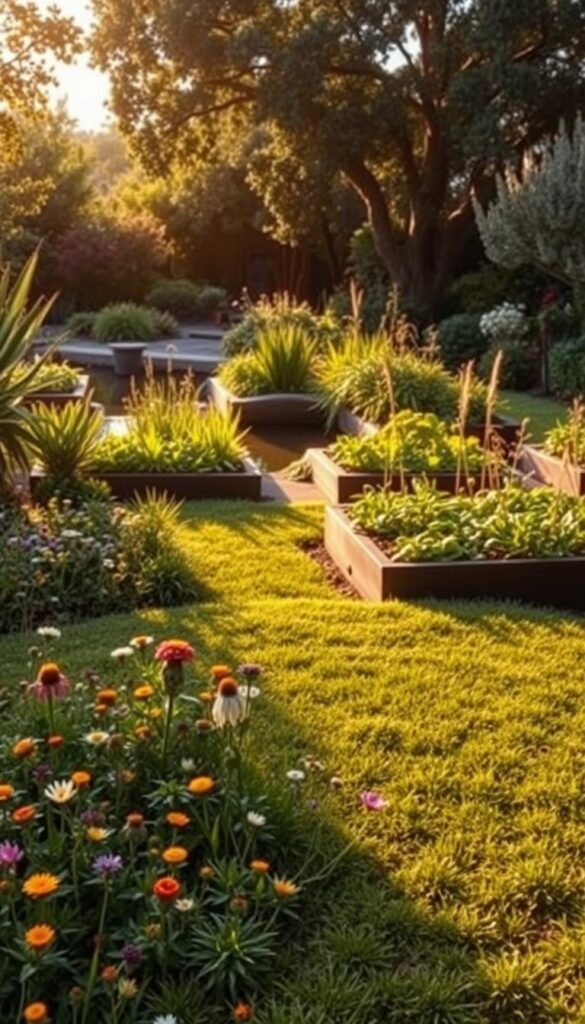
Using green gardening techniques in your garden design can greatly help the environment. By choosing eco-conscious landscaping ideas, you can make your garden both beautiful and eco-friendly.
Working with nature is a key principle in sustainable garden design. This means picking plants that are native to your area and using natural materials for features. For instance, using rainwater harvesting systems and natural stone or wood for paths can make your garden more eco-friendly.
It’s also important to reduce waste and use recycled materials. You can reuse old furniture, make paths from recycled materials, and compost organic waste. This not only cuts down on environmental impact but also makes your garden unique and personal.
Efficient Use of Space
Using space wisely is vital in sustainable garden design. Techniques like vertical gardening and companion planting can make your garden more productive while saving space. This approach also boosts biodiversity and cuts down on the need for fertilizers and pesticides.
By adopting eco-conscious landscaping ideas and green gardening techniques, you can create a garden that’s both stunning and sustainable. This benefits the environment and improves your life by giving you a peaceful and productive outdoor space.
Composting: Turning Waste into Gold
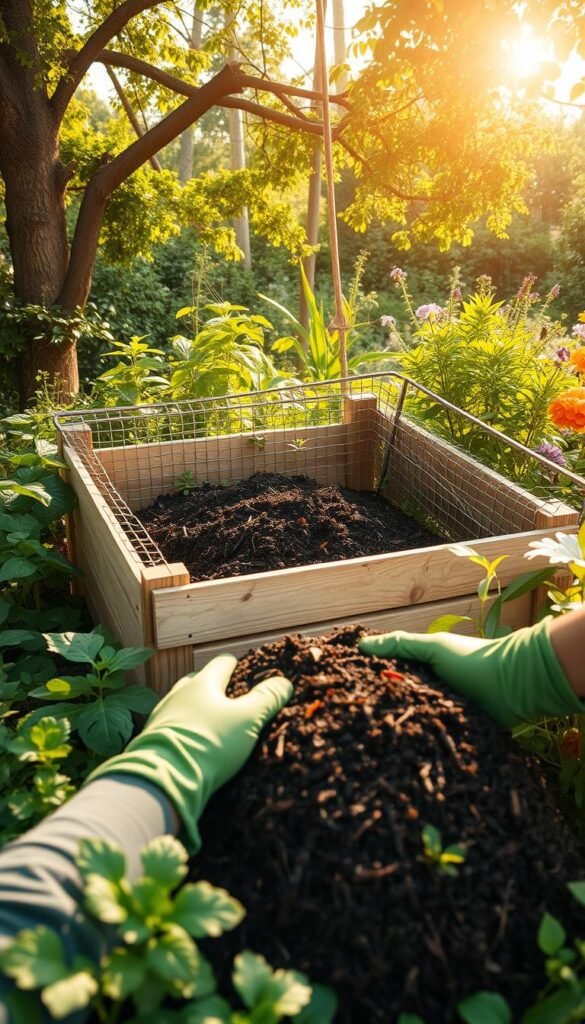
Composting is a key step towards sustainable gardening. It turns waste into a nutrient-rich resource. By using eco-friendly composting strategies, gardeners can cut down on landfill waste.
This method not only helps reduce waste but also boosts soil health. It’s a core part of organic gardening methods. Composting breaks down organic materials like kitchen scraps, leaves, and grass clippings into a fertile soil amendment.
To compost successfully, you need a mix of ‘green’ and ‘brown’ materials. ‘Green’ materials include food scraps and grass clippings. ‘Brown’ materials are dried leaves and straw. Keeping this balance is essential.
Adding compost to your garden improves soil structure and its ability to hold water. It also provides vital nutrients for plants. This supports a healthier and more sustainable garden ecosystem.
Edible Landscaping for Food Sustainability
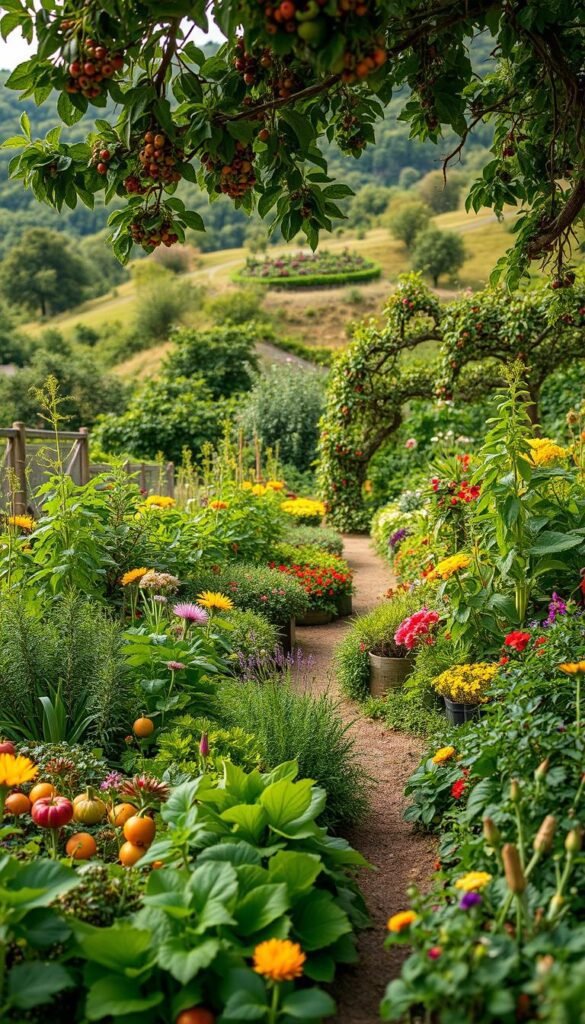
Edible landscaping combines beauty with sustainability, bringing fresh produce to our backyards. It turns our gardens into both stunning and useful spaces. This approach helps us grow food while making our gardens look great.
Edible landscaping mixes plants like fruits, veggies, and herbs into our outdoor areas. It’s a way to garden that’s good for the planet. For example, fruit trees can provide shade, and veggie beds can fit right into the landscape.
One big plus of edible landscaping is it supports eco-friendly garden solutions. Growing your own food cuts down on industrial farming’s carbon footprint. It also encourages organic gardening, which is better for the environment.
To add edible landscaping to your garden, pick plants that look good and grow well. Use a layered design, with tall plants like fruit trees on the north side. Place smaller plants like herbs or leafy greens on the south side. This way, you use space wisely and create a strong ecosystem.
Edible landscaping is a great way to help our planet. It helps us connect with nature, live more sustainably, and enjoy the joy of growing our own food.
Creating Wildlife Habitats

By using eco-conscious landscaping ideas, you can make a wildlife habitat that’s good for you and the planet. This helps local wildlife and makes the ecosystem healthier.
A good wildlife habitat is a home for helpful insects and animals. It makes your garden balanced and healthy. Having one means you need less pesticides because it attracts bees and butterflies.
To welcome wildlife, add native plants for food and shelter. Bird baths, ponds, and log piles also attract many animals. This boosts your garden’s biodiversity.
Creating a wildlife habitat is a smart choice for eco-friendly gardening. It supports your local ecosystem and makes your garden more beautiful. It’s a great way to enjoy your garden more.
By doing this, you help your garden and the environment. It’s a step towards a greener future.
Eco-Friendly Tools and Supplies

Sustainable gardening begins with the basics: earth-friendly garden products. Choosing the right tools and supplies can greatly reduce your environmental impact.
Switching to sustainable gardening tools is a simple way to make your gardening more eco-friendly. Look for items made from recycled materials or sustainably sourced wood. For example, garden forks and rakes made from durable, recycled steel are both effective and good for the planet.
Other important garden supplies include organic fertilizers, natural pest control, and eco-friendly irrigation systems. These help cut down on chemical use and promote healthy soil and plants.
When buying garden supplies, look for items with little packaging or those that are biodegradable. This reduces waste and supports green gardening techniques.
By using eco-friendly tools and supplies, gardeners can make their gardening more sustainable. This benefits both their garden and the environment.
Gardening with Children: Instilling Eco Values
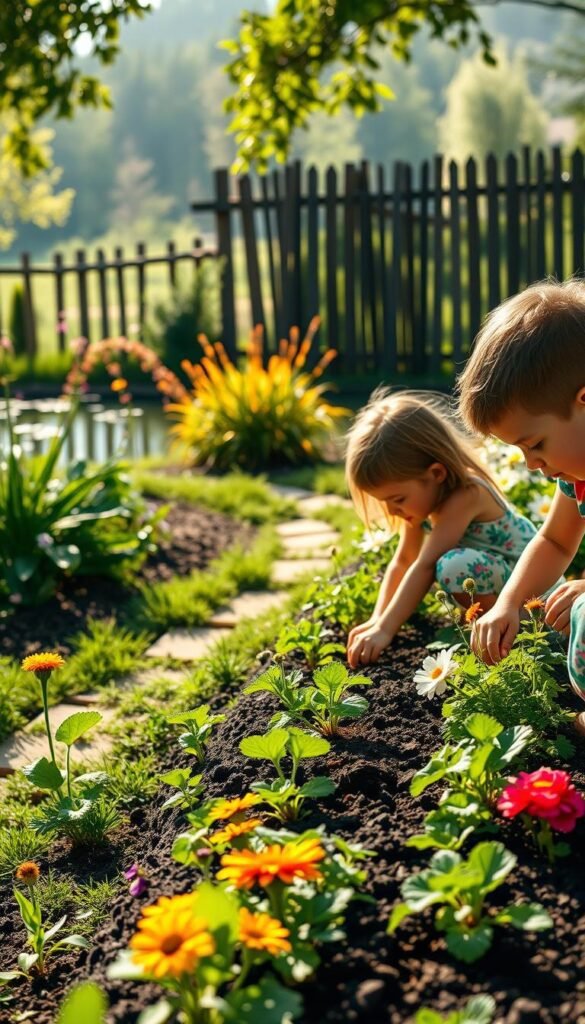
Engaging kids in gardening teaches them to care for the environment. It shows them eco-friendly garden solutions and values that last a lifetime.
Creating a garden for kids is a great way to teach them about sustainable gardening practices. By letting them help with planning, planting, and care, they learn the importance of environmental stewardship.
To make a garden kid-friendly, use colorful plants and interactive elements. Make it a fun and educational place. This way, kids can develop a love for nature and a commitment to sustainable gardening practices.
As kids grow, they become important helpers in the family garden. They learn to appreciate the environment and keep using eco-friendly garden solutions.
Community Involvement in Eco-Friendly Gardening
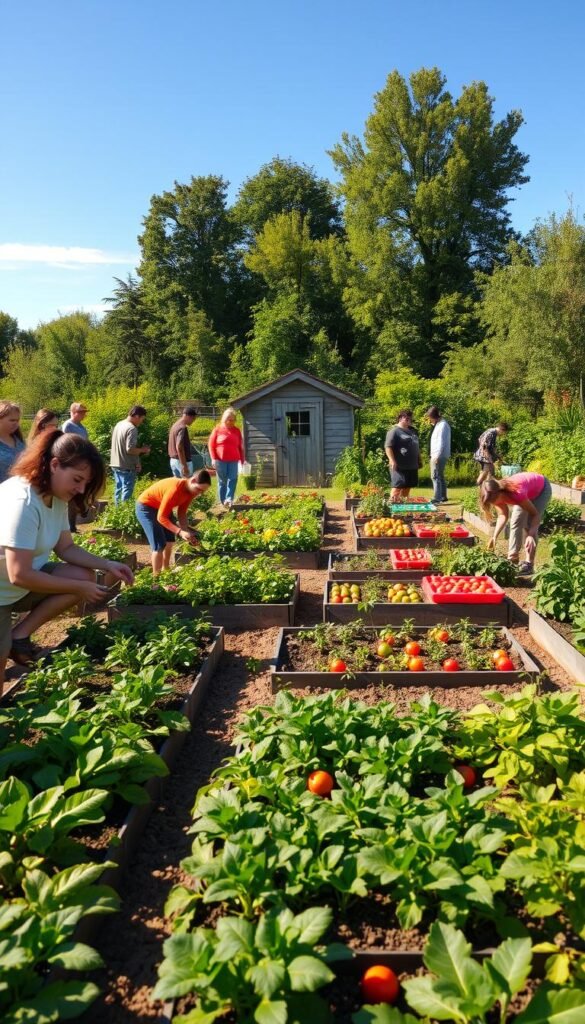
Eco-conscious landscaping ideas can be effectively implemented through community-driven projects. These projects help create a greener and more sustainable environment.
Community gardening initiatives bring people together. They promote unity and cooperation while working towards environmental sustainability. By participating in or organizing these projects, individuals can share knowledge and resources. This enhances the impact of their eco-friendly efforts.
Building a Sustainable Community through gardening involves several strategies. First, identifying community needs and resources is key. Then, implementing eco-conscious landscaping ideas tailored to the community’s conditions and goals is essential.
Community gardening initiatives also serve as educational platforms. Here, individuals learn about sustainable gardening practices. This includes organic soil health, water conservation, and pest management.
This education empowers community members to adopt eco-friendly gardening practices. It also fosters a culture of sustainability.
In conclusion, community involvement is vital for eco-friendly gardening success. By working together and sharing resources, knowledge, and experiences, communities can create thriving eco-friendly gardens. These gardens benefit both the environment and community members.
Future Trends in Eco-Friendly Gardening

Eco-friendly gardening is evolving with new technologies and practices. Smart gardening systems are coming that save water and cut down on waste. These systems, along with green gardening tips, will change how we garden.
Composting is becoming more popular too. It turns waste into compost that feeds plants, reducing the need for harmful fertilizers. This method makes gardens healthier and more sustainable.
The future of gardening looks bright. More people are joining forces to make gardening greener. By using these new methods, we can help our planet and make the world a greener place.


